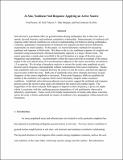| dc.contributor.author | Johnson, Paul | |
| dc.contributor.author | Toksoz, M. Nafi | |
| dc.contributor.author | Morgan, Frank Dale | |
| dc.contributor.author | Pearce, Fred | |
| dc.contributor.other | Massachusetts Institute of Technology. Earth Resources Laboratory | en_US |
| dc.date.accessioned | 2012-01-12T19:14:39Z | |
| dc.date.available | 2012-01-12T19:14:39Z | |
| dc.date.issued | 2009 | |
| dc.identifier.uri | http://hdl.handle.net/1721.1/68335 | |
| dc.description.abstract | Soil sites have a profound effect on ground motion during earthquakes due to their low wave
speeds, layered structure, and nonlinear constitutive relationship. Measurements of nonlinear soil
response under natural conditions are critical to understanding soil behavior during earthquakes.
Currently, quantitative measurements of nonlinear soil response are derived from laboratory
experiments on small samples. In this paper, we extend laboratory methods for measuring
nonlinear soil response to field-scale. We observe the in situ, nonlinear response of a natural soil
formation using measurements obtained immediately adjacent to a large vibrator truck. The
source generates a steady-state wavefield in the soil formation at a range of discrete source
frequencies and amplitudes. Accelerometers within the source provide an estimate of the source
output to the soil, and an array of 4 accelerometers adjacent to the source record the wavefield at
1.5 m spacing. We develop a homodyne analysis to extract the steady-state amplitude at each
discrete source frequency and amplitude without contamination from source harmonics. Steadystate
amplitude ratios are computed between the receivers and the source, and between adjacent
receiver pairs within the array. Both sets of amplitude ratios show dramatic decreases in peak
frequency as the source amplitude is increased. These peak frequency shifts are qualitatively
similar to the nonlinear soil response observed for laboratory samples under resonance
conditions. Amplitude ratios between adjacent receiver pairs suggest the nonlinear soil response
persists across the receiver array and is not limited to the source-soil contact region. The
magnitudes of the observed peak shifts appear to depend on their frequency, a proxy for depth,
which is consistent with the confining pressure dependence of soil nonlinearity observed in
laboratory experiments. Future work will include measurements of steady-state phase velocities
across the array to better understand the nature of nonlinear wave propagation within natural soil
formations. | en_US |
| dc.description.sponsorship | United States. Dept. of Energy (through Los Alamos National Laboratory) | en_US |
| dc.description.sponsorship | Massachusetts Institute of Technology. Earth Resources Laboratory | en_US |
| dc.publisher | Massachusetts Institute of Technology. Earth Resources Laboratory | en_US |
| dc.relation.ispartofseries | Earth Resources Laboratory Industry Consortia Annual Report;2009-12 | |
| dc.subject | Modeling | |
| dc.title | In Situ, Nonlinear Soil Response Applying an Active Source | en_US |
| dc.type | Technical Report | en_US |
| dc.contributor.mitauthor | Toksoz, M. Nafi | |
| dc.contributor.mitauthor | Morgan, Frank Dale | |
| dc.contributor.mitauthor | Pearce, Fred | |
| dspace.orderedauthors | Pearce, Fred; Toksoz, M. Nafi; Morgan, Frank Dale; Johnson, Paul | en_US |
